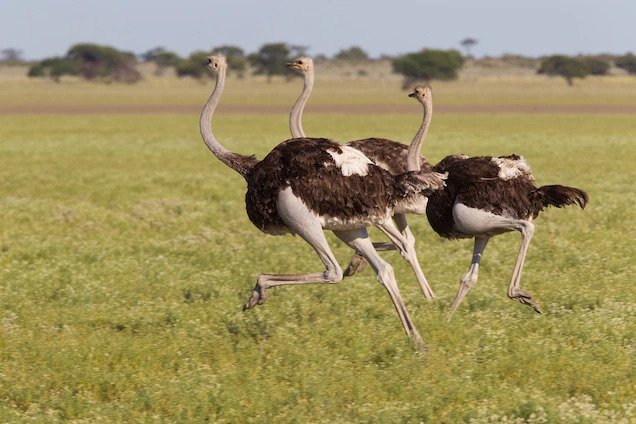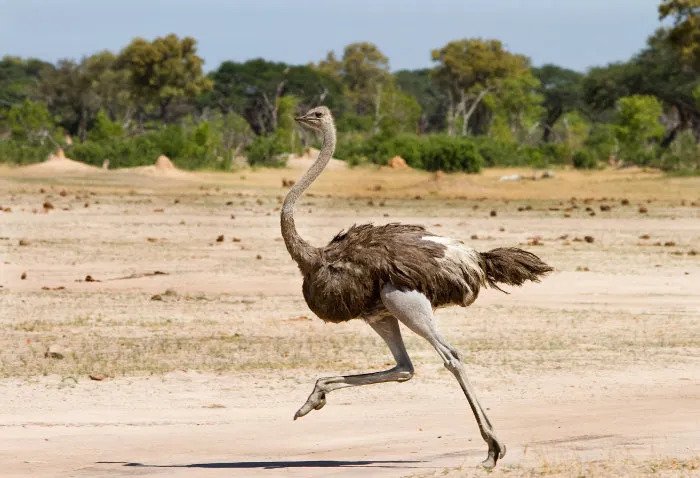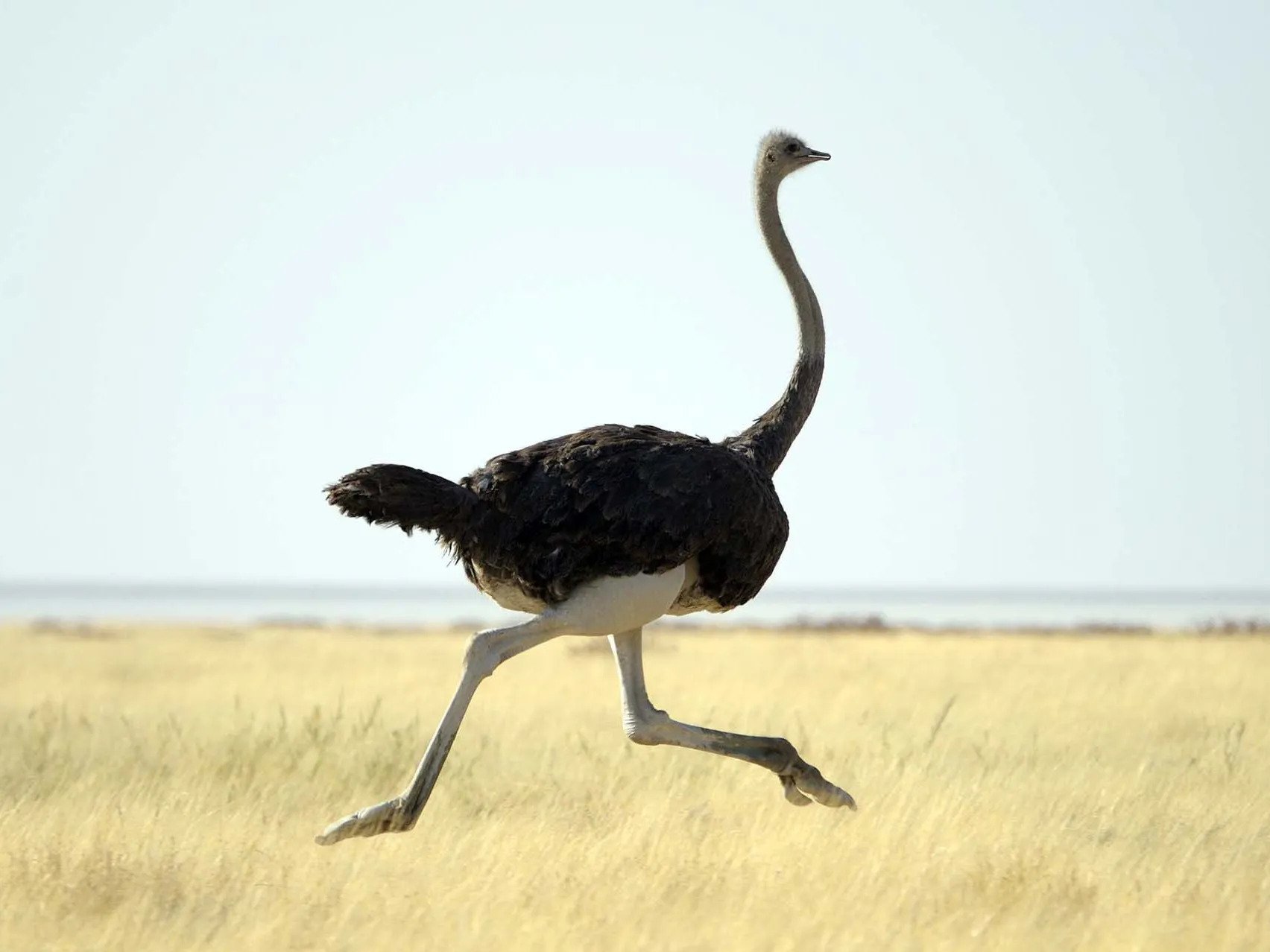How fast can an ostrich run?[VIDEO]
Watch out for ostriches, get out of the way, and see how quickly they can go!
An ostrich can run at 70 km/h because to its long legs! The ostrich is one of the fastest mammals on the African savannah, with a top speed of 45 mph.
But that's only the beginning of the narrative. When you inquire about how fast an ostrich can run, you must also inquire about how and why an ostrich can sprint so quickly. As this article will demonstrate, science is incredible.
How Fast Can An Ostrich Run?

Ostriches may reach speeds of up to 70 km/h (45 mph). In a single stride, they can cover five meters!
Even more astonishing, ostriches can sustain a constant speed of 60 kilometers per hour over long distances. They can complete a 42-kilometer Olympic marathon in less than 40 minutes!
Ostriches are one of the world's most unusual birds, with their long projecting necks and large round bodies. They are savannah's colossi. Ostriches are the largest flightless bird native to Africa, standing over 2.5 meters tall and weighing over 100 kilograms.
Africa is home to two different ostrich species, both of which are capable of sprinting. The most common ostrich is the common ostrich, which has four subspecies.
North African ostriches are highly endangered, Arabian ostriches are extinct, and Masai ostriches in Kenya and Tanzania are barely surviving.
The most common of these birds is the South African ostrich, which is native to Southern Africa. The South African Karoo is home to almost 90% of the world's ostriches.The Somali ostrich is a threatened species found in Somalia, Ethiopia, and Kenya. They are smaller than typical ostriches and can travel at speeds of up to 70 km/h.
WHY DON’T OSTRICH FLY?

Ostriches are birds that cannot fly. Many people assume that because ostriches are so hefty, they can't fly. True, but ostriches were never this large.
Millions of years have passed since these birds first appeared on the scene. They are, in fact, one of Africa's oldest mammals.
There wasn't much room for ostriches when dinosaurs controlled the globe. They were significantly lighter and had the potential to fly back then. The dinosaurs were then wiped out, leaving plenty of room for ostriches to run around in.
The Southern Hemisphere is home to a variety of large flightless birds. Ostriches are genetically close to Australian emu and South American rhea. Ostrich and kiwi birds from New Zealand share significant genetic connections with the now-extinct huge Madagascan elephant bird.
All of these birds descended from a single progenitor who flew around the globe. For various causes, each evolved independently and lost the ability to fly.
Ostriches have adapted to the greater room on the African savannah over millions of years. They roamed the land, consuming all of the vegetation that had previously been eaten by dinosaurs.
They became fat and heavy as a result of the increased food, and their wings could no longer carry them.
How Do Ostrich Run So Fast?

USING THEIR WINGS
Humans have tailbones, which are the superfluous bones at the bottom of our spine that serve no purpose. We have tailbones because we inherited them from our primate ancestors.
Although ostriches do not fly, they do have wings. These wings determine how fast an ostrich can run. Ostriches utilize their wings, which have a span of more than two metres, to guide and balance themselves at fast speeds.
When running at great speeds, an ostrich uses minor wing motions to keep its equilibrium, just like an airplane.
Humans will lose their tailbones in the future. It's a natural part of the process. Ostriches, on the other hand, will not lose their wings because they can only run in a straight line without them.
ELASTIC LEGS
What is the fastest speed an ostrich can run? Ostriches, on the other hand, can cover up to five meters in a single stride! As both feet leave the ground at the same time, their light legs bounce across the African grassland.
To help them run quickly, leopards and lions have robust leg muscles. Cheetahs, the fastest land mammal, are built similarly to ostriches. They have long, slender legs that are meant to help them balance and accelerate.
The science behind running speed is the same whether you're Usain Bolt or a little snail. You can run faster by lengthening your stride or increasing the frequency of your steps.
Ostriches have the longest legs of any flightless bird, allowing them to take longer strides.
Their legs have all of their muscle close to their bodies. When compared to humans, ostriches have extraordinarily robust upper thigh and buttock muscles, but little calf muscles.
Because their leg muscles are closer to their body, ostriches can swing their legs faster than most other animals. These muscles offer strength, and their long, light legs provide distance.
A PERFECT CENTRE OF GRAVITY
These flightless birds don't appear to be in good running shape. Isn't that large bouncing round tummy a speed stumbling block? No, not at all. Ostriches can keep all of their essential organs safe and protected behind their wings, allowing them to run faster.
Every bird has an extremely well-positioned center of gravity, which allows for tremendous mobility. Just observe how a bird lands with ease on any perch.
Because their center of gravity is located between their lengthy legs and wings, ostriches are ideally proportioned. So, no matter how fast they run or how out of control they appear to be, they are always perfectly balanced.
Our leg muscles move us forward while we run. Our leg muscles, on the other hand, expend a lot of energy in order to keep us upright.
Long-distance Olympic runners who look to run effortlessly are the finest. They expend the majority of their energy in order to go forward.
Most of us aren't Olympians when it comes to running. Because our muscles have to keep us moving in a straight line, we get tired easily.
Ostriches have a very efficient strategy. They can move forward with all of their physical force because their center of gravity maintains them perfectly balanced.
That is why an ostrich can run at 60 kilometers per hour for such a long distance.
Why Do Ostrich Run So Fast?
You now have a better understanding of how quickly an ostrich can run. But why do ostriches sprint so quickly?
ESCAPING PREDATORS

Ostriches can run at speeds of up to 70 kilometers per hour. As you can see from this list of Africa's fastest antelope, that max speed is similar to that of many African antelope.
70 km/h is comparable to the speed of some of the ostrich's predators, implying that Mother Nature and evolution are in perfect harmony. Leopards can only run at 60 km/h, but lions can run at 80 km/h.
As a result, we can hypothesize that ostriches run quickly to avoid their predators. After all, if they can't fly, they'll have to find another way to get away.
As a result, ostriches can sprint quickly to dodge the most dangerous predators. They may also run for large distances to evade hyenas.
Hyenas and wild dogs pursue down their prey over large distances, exhausting it. Hyenas and wild dogs, on the other hand, lack the ostrich's extraordinary endurance and speed.
FRESH GRAZING PASTURES
Ostriches have evolved to survive in arid regions. As a result, they must travel large distances to find food. Ostriches can also run quickly in order to discover new feeding areas quickly.
The sight of an ostrich running is breathtaking. One of the joys of an African safari is tracking an ostrich across a long distance. The safari truck frequently can't keep up with the ostriches as they run and run and run.
When most people see an ostrich, they think to themselves, "What a foolish looking animal!" However, because of their very unique biochemistry, ostriches are one of the quickest animals on the African savannah.
Hopefully, you will see one sprinting through the African plains soon.




